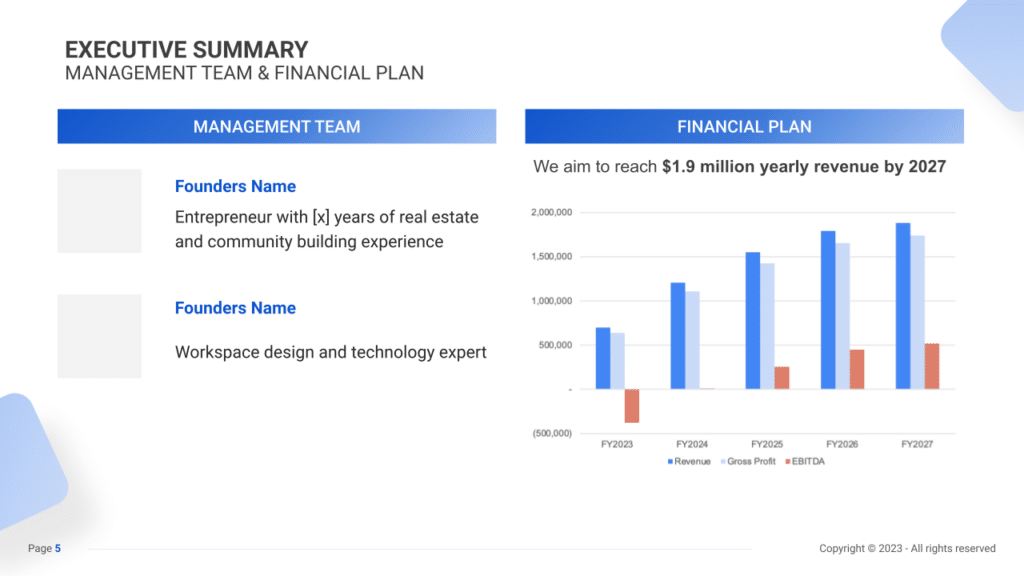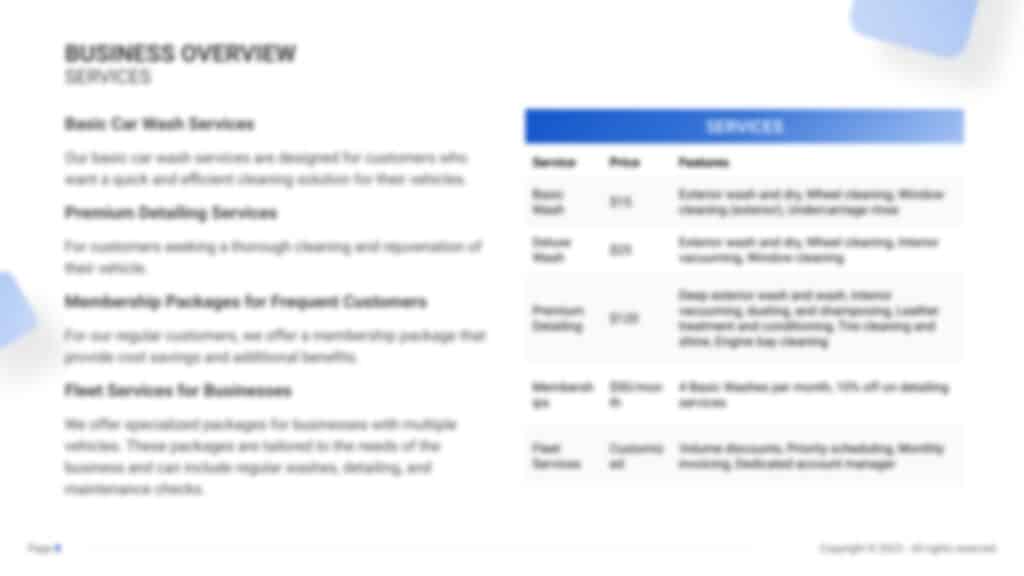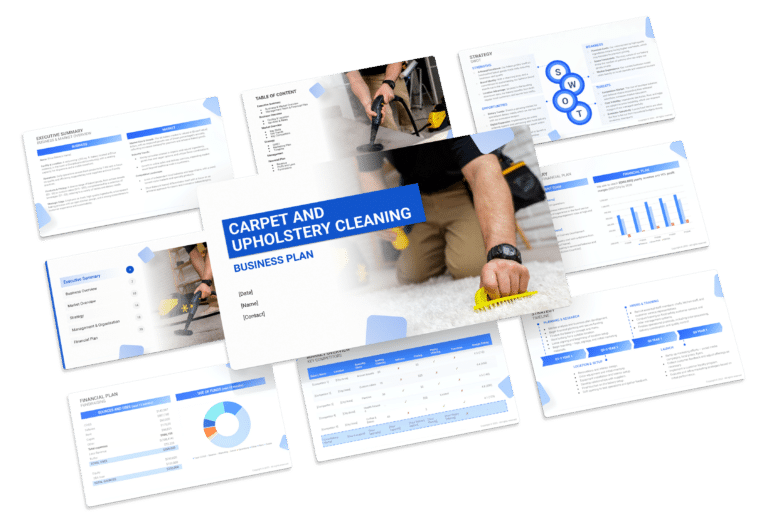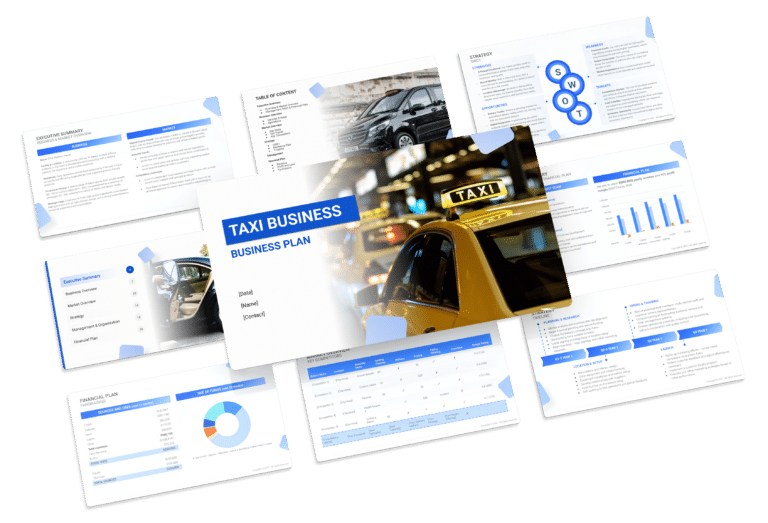Car Wash Business Plan Template & PDF Example

Creating a comprehensive business plan is crucial for launching and running a successful car wash. This plan serves as your roadmap, detailing your vision, operational strategies, and financial plan. It helps establish your car wash’s identity, navigate the competitive market, and secure funding for growth.
This article not only breaks down the critical components of a car wash business plan, but also provides an example of a business plan to help you craft your own.
Whether you’re an experienced entrepreneur or new to the service industry, this guide, complete with a business plan example, lays the groundwork for turning your car wash concept into reality. Let’s dive in!
The Plan
Our car wash business plan is designed to encompass all vital components necessary for a well-rounded strategy. It details the car wash’s operations, marketing approaches, market landscape, competitors, leadership team, and financial projections.
- Executive Summary: Presents a snapshot of the car wash business idea, market evaluation, management team, and financial tactics.
- Business Overview: Elaborates on the offerings and operational framework of your car wash:
- Car Wash & Location: Explains the setup, features, and strategic location choice for attracting customers.
- Services & Pricing: Enumerates the car wash services, including various cleaning options and pricing models.
- Market Overview: Delves into the car wash industry, pinpointing competitors and your business’s unique position:
- Key Stats: Provides industry scale, growth patterns, and important market data for the car wash sector.
- Key Trends: Outlines current trends influencing the car wash industry.
- Key Competitors: Evaluates prominent local competitors and differentiates your car wash from them.
- Strategy: Describes the roadmap for growth and client acquisition:
- SWOT: Analysis of strengths, weaknesses, opportunities, and threats.
- Marketing Plan: Tactics for drawing in and keeping customers.
- Timeline: Important goals and benchmarks from the outset through the initial year.
- Management: Details on the car wash’s management team and their roles.
- Financial Plan: Forecasts the car wash’s financial outlook over five years, covering income, profit margins, and anticipated costs.

Executive Summary
The Executive Summary introduces your car wash business plan, offering a concise overview of your car wash facility and its services. It should detail your market positioning, the range of car cleaning and detailing services you offer, its location, size, and an outline of day-to-day operations.
This section should also explore how your car wash will integrate into the local market, including the number of direct competitors within the area, identifying who they are, along with your car wash’s unique selling points that differentiate it from these competitors.
You should also include information about the management and co-founding team, detailing their roles and contributions to the car wash’s success.
Additionally, a summary of your financial projections, including revenue and profits over the next five years, should be presented here to provide a clear picture of your car wash’s financial plan.
Car Wash Business Plan Executive Summary Example


Business Overview
The business overview is essential for detailing your car wash’s operational model and services. This section should emphasize the unique aspects of your car wash, including the range of services offered and any special features or benefits that set it apart from competitors.
Example:
CarWashPro, located in a prime area of [City], provides a wide array of services, from basic car washes to premium detailing. It stands out with its commitment to eco-friendly washing methods, exclusive membership benefits, and specialized fleet services, catering to individual car owners and businesses alike.
Market Overview
A market analysis for the car wash industry should include an evaluation of the industry’s size, growth trajectory, and emerging trends. This analysis positions your business within the broader industry and identifies key areas where you can capitalize on current consumer demands and market shifts.
Example:
CarWashPro enters a U.S. car wash market valued at $17.3 billion, growing steadily due to the increasing number of vehicles and a rising preference for eco-friendly services. The car wash’s focus on sustainability and convenience places it at the forefront of industry trends, distinguishing it in a competitive local market with six other car wash services.
Management Team
This section should outline the background and expertise of the management team, highlighting how their experience and skills contribute to the strategic direction and operational success of the car wash business.
Example:
The management team of CarWashPro is led by an entrepreneur with extensive experience in real estate and a technology expert skilled in workspace design. Their combined expertise is instrumental in establishing CarWashPro’s operational efficiency and innovative service approach.
Financial Plan
The financial plan overview should include revenue targets and profit margin goals. This section provides a clear picture of the financial aspirations of the car wash and its projected financial health and growth.
Example:
CarWashPro aims to achieve $1.9 million in annual revenue with an 11% profit margin by 2027. This ambitious yet achievable target is underpinned by a strategic marketing approach, a focus on high-quality services, and operational excellence.
Business Overview
For a Car Wash, the Business Overview section can be adapted and concisely divided into 2 main categories:
Car Wash & Location
Briefly describe the car wash’s physical setup, focusing on its design, efficiency, and the welcoming environment it creates for customers. Mention the car wash’s location, emphasizing its accessibility and the convenience it offers to customers, such as proximity to major roads, shopping centers, or residential areas. Explain why this location is advantageous for attracting your target clientele.
Services & Pricing
Detail the range of car wash and detailing services offered, from basic exterior washes to comprehensive interior and exterior detailing. Outline your pricing strategy, ensuring it reflects the quality of services provided and is competitive within the market you’re targeting. Highlight any special packages, membership deals, or loyalty programs that provide added value to your customers, encouraging repeat business and fostering customer loyalty.


Market Overview

Industry Size & Growth
In the Market Overview of your car wash business plan, start by examining the size of the car wash industry and its growth potential.
This analysis is essential for understanding the market’s breadth and pinpointing opportunities for expansion. Consider factors like the increasing number of vehicles, urbanization, and the growing consumer preference for professional car care services over DIY methods.
Key Market Trends
Proceed to discuss recent market trends, such as the rising consumer interest in eco-friendly and water-saving car wash technologies, the popularity of comprehensive detailing services, and the integration of digital technologies for enhanced customer experiences.
For instance, highlight the demand for services that use environmentally friendly cleaning agents, the adoption of automated systems for efficiency, and the trend towards subscription-based models for regular customers.
Competitive Landscape
A competitive analysis is not just a tool for gauging the position of your car wash in the market and its key competitors; it’s also a fundamental component of your business plan.
This analysis helps in identifying your car wash’s unique selling points, essential for differentiating your business in a competitive market.
In addition, competitive analysis is integral in laying a solid foundation for your business plan. By examining various operational aspects of your competitors, you gain valuable information that ensures your business plan is robust, informed, and tailored to succeed in the current market environment.
Identifying Competitors in the Car Wash Industry
Begin by identifying direct and indirect competitors within the car wash industry. Direct competitors encompass nearby car washes offering similar services—ranging from self-service bays to full-service detailing.
Indirect competitors might include mobile detailing services, dealership offerings, or even at-home car cleaning products.
Utilize various tools such as Google Maps, industry directories, and local business listings to map out competitor locations.
Online platforms like Yelp, Google Reviews, or specialized car forums provide a treasure trove of customer reviews, offering valuable insights into competitor strengths and areas needing improvement.

Car Wash Competitors’ Strategies
A comprehensive analysis of competitors’ strategies encompasses various dimensions:
- Service Offerings: Evaluate the diversity and quality of services provided by competitors. For instance, a rival emphasizing interior detailing or specialized treatments like ceramic coating might attract a different segment of customers seeking these specific services.
- Pricing Strategies: Compare pricing structures and service packages. Assess whether your car wash aims to be a cost-effective option or positions itself as a premium service provider, aligning with higher-end competitors.
- Technological Advancements: Investigate competitors’ integration of technology to enhance service quality and efficiency. Consider features like automated payment systems, water recycling methods, or eco-friendly detergents, and their impact on customer satisfaction and operational efficiency.
- Customer Engagement: Evaluate how competitors interact with customers. This may include loyalty programs, customer feedback mechanisms, online appointment scheduling systems, or a robust social media presence used for promotions and engagement.
- Location and Accessibility: Consider the impact of location on customer reach. A car wash situated in a bustling commercial area might target commuters seeking quick and efficient washes, while a suburban location might cater to customers valuing a more leisurely and thorough cleaning experience.
What’s Your Car Wash’s Unique Value Proposition?
Identify the distinctive aspects that set your car wash apart from the competition. It could be specialized services such as paint restoration, a focus on luxury vehicle care, or unique environmentally friendly practices.
Conduct thorough market research to identify gaps through customer feedback and emerging industry trends. For example, suppose there’s an increasing demand for waterless car wash solutions in your area, yet few competitors offer this service. In that case, it could represent a lucrative niche for your car wash to fill.
Consider local demographics and preferences while shaping your car wash’s offerings. A car wash located near office complexes might prioritize speed and convenience for busy professionals, while one situated in a residential neighborhood might emphasize a family-friendly atmosphere and additional amenities like vacuum stations and pet wash areas.
Strategy

SWOT
First, conduct a SWOT analysis for the car wash, highlighting Strengths (such as state-of-the-art equipment and a comprehensive range of services), Weaknesses (including potential environmental concerns or high initial setup costs), Opportunities (for example, the growing environmental consciousness leading to a preference for professional car washes over home washing), and Threats (such as water usage regulations or economic downturns that may impact discretionary spending).

Marketing Plan
Next, develop a marketing strategy that outlines how to attract and retain customers through targeted advertising, promotional offers, loyalty programs, an engaging online presence, and participation in local events.
Marketing Channels
Utilizing diverse marketing channels helps in reaching potential customers effectively and reinforcing brand presence in the market.
Digital Marketing
- Social Media: Utilize social media platforms such as Instagram, Facebook, Twitter, and YouTube to showcase your car wash’s services, customer testimonials, and behind-the-scenes operations. Engaging content, including before-and-after cleaning photos and interactive posts, helps build a loyal online community.
- Website and SEO: Maintaining an informative, user-friendly website optimized for local SEO (Search Engine Optimization) is vital for attracting local customers. Online booking options, service descriptions, customer reviews, and a blog featuring car care tips can enhance user experience and credibility.
Local Advertising
- Flyers and Local Print: Distribute visually appealing flyers and brochures in nearby neighborhoods, local events, and shopping centers to increase awareness. Advertisement placements in local newspapers, automotive magazines, or community newsletters tailored to car enthusiasts amplify your reach within the local community.
- Community Engagement: Engaging with the community by sponsoring local car shows, participating in charitable events, or organizing car care workshops fosters a positive brand image and establishes connections with potential customers.
Partnerships
- Collaborate: Collaborate with auto dealerships, gas stations, or car rental agencies to offer joint promotional deals or exclusive discounts to each other’s customers. Forming partnerships with businesses that cater to car owners, such as car accessory shops or maintenance centers, can provide cross-promotional opportunities.
- Fleet Services: Consider establishing contracts with companies managing vehicle fleets, such as taxi services or delivery companies, to offer regular cleaning packages or discounted rates for bulk services.
Promotional Activities
- Special Deals: Introduce seasonal promotions like ‘Summer Shine Packages’ or ‘Holiday Detailing Specials’ to attract new customers and encourage repeat visits. First-time customer discounts or exclusive deals for loyalty cardholders can drive customer acquisition and retention.
- Loyalty Programs: Implementing a structured loyalty program where customers earn points for each service availed encourages frequent visits. Offering redeemable rewards, such as discounts, free washes, or complimentary services, incentivizes customers to continue patronizing your car wash.

Sales Channels
Maximizing revenue streams involves optimizing sales within the car wash premises and exploring online sales avenues.
In-Person Upselling
- Additional Services: Train staff to effectively recommend additional services such as interior detailing, waxing, protective coatings, or air fresheners during car wash bookings or on-site visits. Highlighting the benefits of these add-ons enhances the customer experience and increases sales per transaction.
- Retail Products: Displaying car care products and accessories for purchase near the checkout area encourages impulse buying. Offering demonstrations or educating customers on the benefits of these products for at-home car maintenance can lead to additional sales.
Online Booking and Sales
- Online Booking System: Implement a user-friendly and secure online booking system on your website and social media platforms. Offering incentives such as discounted packages or exclusive deals for online bookings encourages customers to utilize this convenient option.
- E-commerce: E-commerce integration on your website enables the sale of car care products, gift cards, or monthly subscription plans. Providing detailed product descriptions, customer reviews, and secure payment options enhances the online shopping experience, leading to increased sales.
Membership and Loyalty Programs
- Membership Options: Develop monthly or yearly subscription plans offering unlimited washes or discounted rates for loyal customers. Tailor these membership options to cater to different customer preferences, such as basic, premium, or VIP packages.
- Rewards Program: Implement a digital rewards system where customers earn points for each service they avail of. These points can be redeemed for discounts, complimentary services, or exclusive benefits, encouraging customers to return and accumulate points.
Strategy Timeline
Finally, create a detailed timeline that outlines critical milestones for the car wash’s launch, marketing initiatives, customer base development, and potential expansion or diversification plans, ensuring the business advances with clear direction and purpose.

Management
The Management section focuses on the car wash’s management and their direct roles in daily operations and strategic direction. This part is crucial for understanding who is responsible for making key decisions and driving the car wash toward its financial and operational goals.
For your car wash business plan, list the core team members, their specific responsibilities, and how their expertise supports the business.


Financial Plan
The Financial Plan section is a comprehensive analysis of your financial projections for revenue, expenses, and profitability. It lays out your car wash’s approach to securing funding, managing cash flow, and achieving breakeven.
This section typically includes detailed forecasts for the first 5 years of operation, highlighting expected revenue, operating costs and capital expenditures.
For your car wash business plan, provide a snapshot of your financial statement (profit and loss, balance sheet, cash flow statement), as well as your key assumptions (e.g. number of customers and prices, expenses, etc.).
Make sure to cover here
_ Profit and Loss
_ Cash Flow Statement
_ Balance Sheet
_ Use of Funds









